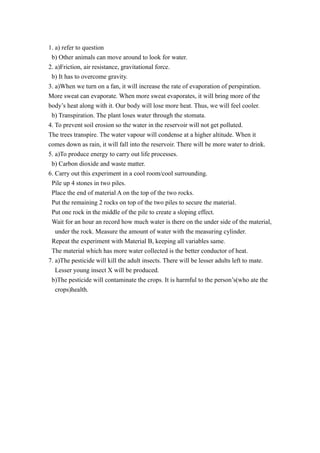
Science paper 2012 answer sheet
- 1. 1. a) refer to question b) Other animals can move around to look for water. 2. a)Friction, air resistance, gravitational force. b) It has to overcome gravity. 3. a)When we turn on a fan, it will increase the rate of evaporation of perspiration. More sweat can evaporate. When more sweat evaporates, it will bring more of the body’s heat along with it. Our body will lose more heat. Thus, we will feel cooler. b) Transpiration. The plant loses water through the stomata. 4. To prevent soil erosion so the water in the reservoir will not get polluted. The trees transpire. The water vapour will condense at a higher altitude. When it comes down as rain, it will fall into the reservoir. There will be more water to drink. 5. a)To produce energy to carry out life processes. b) Carbon dioxide and waste matter. 6. Carry out this experiment in a cool room/cool surrounding. Pile up 4 stones in two piles. Place the end of material A on the top of the two rocks. Put the remaining 2 rocks on top of the two piles to secure the material. Put one rock in the middle of the pile to create a sloping effect. Wait for an hour an record how much water is there on the under side of the material, under the rock. Measure the amount of water with the measuring cylinder. Repeat the experiment with Material B, keeping all variables same. The material which has more water collected is the better conductor of heat. 7. a)The pesticide will kill the adult insects. There will be lesser adults left to mate. Lesser young insect X will be produced. b)The pesticide will contaminate the crops. It is harmful to the person’s(who ate the crops)health.
